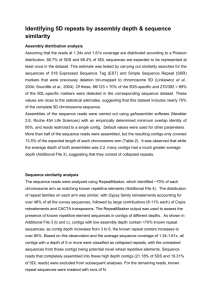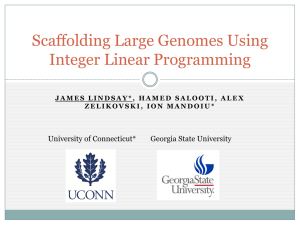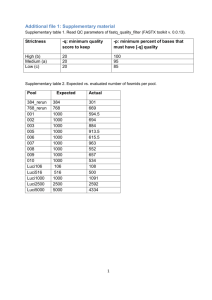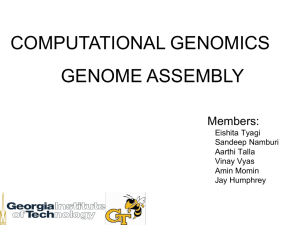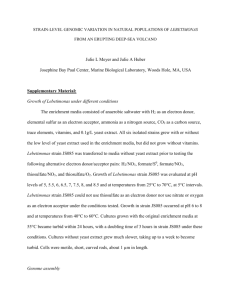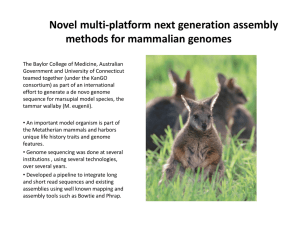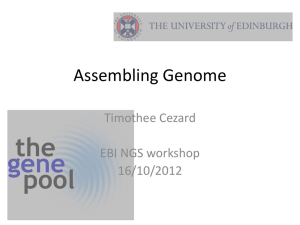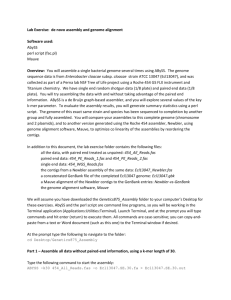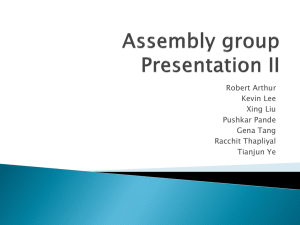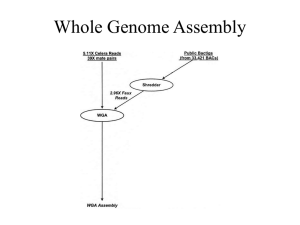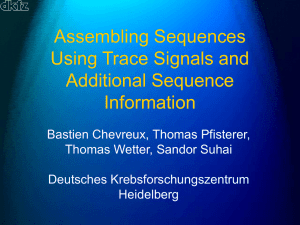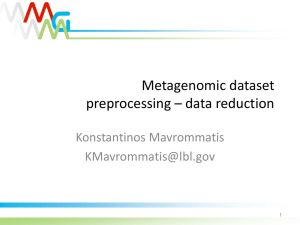Assembly Presentation #1
advertisement
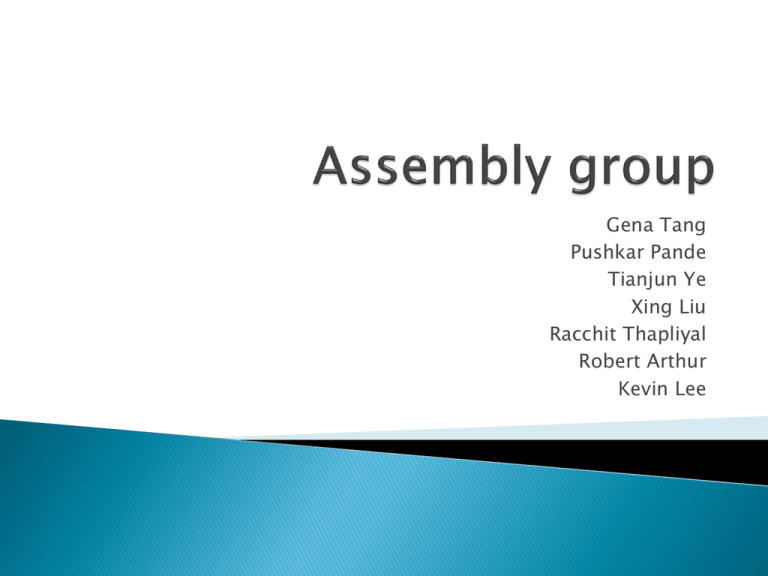
Gena Tang
Pushkar Pande
Tianjun Ye
Xing Liu
Racchit Thapliyal
Robert Arthur
Kevin Lee
Biology background
Algorithms
De novo
- Overlap-Layout-Consensus
- De Bruijn graphs
Reference
Tools and Techniques
Work flow & strategy
Group management
Biology background
Algorithms
De novo
- Overlap-Layout-Consensus
- De Bruijn graphs
Reference
Tools and Techniques
Work flow & strategy
Group management
Flow Order
4-mer
3-mer
2-mer
1-mer
T
A
C
G
KEY (TCAG)
Measures the
presence or absence
of each nucleotide at
any given position
http://www.youtube.com
/watch?v=kYAGFrbGl6E
Margulies et al., 2005
~300nt per read
40X coverage (but widely varying, 12-80)
~ 2 Mb genome (1.8-2.0Mb)
Mostly coding sequences
◦ Good for assembly
Reference genomes of 4 closely related
species
◦
◦
◦
◦
H.
H.
H.
H.
influenzae
parasuis
ducreyi
somnus
High degree of genomic plasticity
◦ 10% of genes in clinically isolated strains are novel
In situ horizontal gene transfer
Supragenome – distributed genome
hypothesis
Reference mapping relatively ineffective
Making life difficult!!!
De novo
Reference mapping
Number of large
contigs
50
500+
Unmapped reads
1300
68000+
N50 contig size
28500
3000
Bases in large contigs
(Mb)
2
1.3
Assemble all of the H. hemolyticus genomes
together
Should give a more complete mapping
because of higher coverage
◦ 40X * 5 genomes 200X coverage
But … we get 3700 contigs
◦ (average of 50 for single strain assembly)
These data hint at rampant recombination
Reference mapping relatively worthless
Whole-genome alignment (intra-species)
◦ On average, 27 insertions, 147 deletions (>90bp)
◦ Average length of non-matching seq = 321kb (18%)
Biology background
Algorithms
De novo
- Overlap-Layout-Consensus
- De Bruijn graphs
Reference
Tools and Techniques
Work flow & strategy
Group management
Read: a 500-900 long word that comes out of
sequencer
Mate pair: a pair of reads from two ends of
the same insert fragment
Contig: a contiguous sequence formed by
several overlapping reads with no gaps.
Supercontig (scaffold) an ordered and
oriented set of contigs, usually by mate pairs.
Consensus sequence: sequence derived from
the multiple alignment of reads in a contig
Goal: Find the shortest common sequence of
a set of reads.
Input: reads {s1, s2, s3, …}
Output: find the shortest string T such that
every s_i is a substring of T.
Comment: This is NP-hard problem, we need
to use some approximation algorithm.
(1)
(2)
(3)
(4)
Process:
Calculate pairwise alignments of all
fragments.
Choose two fragments with the largest
overlap.
Merge chosen fragments.
Repeat step 2 and 3 until only one fragment
is left.
Input reads
Take pairwise
alignment
Best one
Merge the best
one
Comment:
Greedy algorithm was the first successful
assembly algorithm implemented.
Used for organisms such as bacteria, singlecelled eukaryotes.
It has some efficiency limitation
This approach is based on graph theory.
Assemblers based on this approach: Arachne,
Celera, Newbler etc.
(1)
(2)
Sort all k-mers in reads (k~24)
Find pairs of reads sharing a k-mer
Extend to full alignment-throw away if not
> 95% similar
TACATAGATTACACAGATTACT
GA
| |
| | | |||| | || | | ||||
| | | |
TAGTTAGATTACACAGATTACTAG
A
One caveat: repeats
A k-mer that appears N times, initiates N^2
comparisons.
Solution:
Discard all k-mers that appear more than
c*Coverage, (c~10)
(1)
(2)
A graph is constructed:
Nodes are reads
Edges represent overlapping reads
CGTAGTGGCAT
Overlap graph
ATTCACGTAG
(1)
(2)
A graph is constructed:
Nodes are reads
Edges represent overlapping reads
CGTAGTGGCAT
Overlap graph
ATTCACGTAG
(1)
(2)
(3)
Terminology in graph theory:
Simple path--- a path in the graph contains each node at most
once.
Longest simple path---a simple path that cannot be extended.
Hamiltonian path– a path in the graph contains each node exactly
once.
CGTAGTGGCAT
ATTCACGTAG
Recall: Now we got several contigs(i.e. several
longest simple paths)
Find the multiple alignments of these contigs,
and get one consensus sequence as our final
contig.
(1)
(2)
(3)
(4)
Summary:
Based on graph theory
Eularian path: a path in a graph which visits
every edge exactly once.
Example: Euler, Velvet, Allpath, Abyss,
SOAPdenovo…
Eularian path is more efficient, however, in
partice both are equally fast.
Break reads into overlapping k-mers.
Example:
10bp read: ATTCGACTCC
for k=5-mers: ATTCG
TTCGA
TCGAC
CGACT
GACTC
ACTCC
Nodes: k-mers
Edges: if (k-1) suffix of a node equals (k-1)
prefix of a node, add a directional edge
between them.
ATTCG
TTCGA
TCGAC
Whenever a node A has only one outgoing arc
that points to another node B that has only
one ingoing arc, the two nodes are merged.
TGCAT
TTGCA
ATTGC
TGCAG
ATTGCA
In Velvet:
(1) Error removal
(2) Removing tips
Tip: a chain of nodes that is disconnected on
one end.
Consider two paths redundant if they start
and end at the same nodes (forming a
“bubble”) and contain similar sequences.
Such bubbles can be created by errors or
biological variants, such as SNPs or cloning
artifacts prior to sequencing. Erroneous
bubbles are removed by an algorithm called
“Tour Bus”.
Algorithm for directed graphs:
(1) Start with an empty stack and an empty circuit (Eulerian path).
- If all vertices have same out-degrees as in-degrees - choose any of them.
- If all but 2 vertices have same out-degree as in-degree, and one of those 2
vertices has out-degree with one greater than its in-degree, and the other
has in-degree with one greater than its out-degree - then choose the vertex
that has its out-degree with one greater than its in-degree.
- Otherwise no Euler circuit or path exists.
(2) If current vertex has no out-going edges (i.e. neighbors) - add it to circuit,
remove the last vertex from the stack and set it as the current one. Otherwise
(in case it has out-going edges, i.e. neighbors) - add the vertex to the stack,
take any of its neighbors, remove the edge between that vertex and selected
neighbor, and set that neighbor as the current vertex.
(3) Repeat step 2 until the current vertex has no more out-going edges
(neighbors) and the stack is empty.
C_k=C*(L-k+1)/L
N50 size: 50% of genome is in contigs larger than
N50
Example:
1Mbp genome
Contigs: 300, 100, 50, 45, 30, 20, 15, 15, 10,…
N50=30kbp
(300+100+50+45+30=525>=500kbp)
Note: N50 is meaningful for comparison only when
genome size is the same
Map k-mer on the reference sequence, get a
“location map”.
Map each read onto the “location map”
according to the k-mer.
AATTG
CCCAATTGAAA
GGTTA
AATGGTTACCA
location map of
5-ker
Biology background
Algorithms
De novo
- Overlap-Layout-Consensus
- De Bruijn graphs
Reference
Tools and Techniques
Work flow & strategy
Group management
Standard flowgram format (SFF)
A binary file format used to encode results
of pyrosequencing from the 454 Life Sciences
platform for high-throughput sequencing.
a header section + read data sections
A summary of general
information regarding the file
content
Reads' universal accession numbers (h),
sequence information (s),
quality scores of basecalls (q),
clipping positions (c),
flowgram values (f)
flowgram indices (i)
the nucleotide bases + the quality scores
6 genomes, 6 .sff files
Number of reads ranges from 72548 to
391117
Assembler
Reads
Contigs/
Scaffold
GS De Novo Assembler: a software package designed
specifically for assembling sequence data generated
by pyrosequencing platforms
De novo assembly
Overlap-Layout-Consensus methodology
Better deal with reads greater than 250bp in length
GS Reference Mapper
Algorithms for de novo assembly
Short read assembly (25~50bp)
Using de Bruijn graphs.
Applying Velvet to very short reads and
paired-ends information only can produce
contigs of significant length, up to 50-kb
N50 length in simulations of prokaryotic data
and 3-kb N50 on simulated mammalian
BACs.
Open-source whole genome assembly
software
- Assemblers: Minimus2
- Validation and Visualization: Hawkeye
- Scaffolding: Bambus
- Trimming, Overlapping, & Error Correction
Celera
MIRA
Edena
Finishing is a
big challenge !
Sequencing errors: base pair misread, poly A…
It is possible that some portions of genomes
are unsequenced
Identical and nearly identical sequences
(repeats) can increase the time and space
complexity of algorithms exponentially
Gaps & errors
• Finishing is taking contigs and yielding a complete
sequence.
• Scaffolder orders contigs into scaffolds based on
clone-mate pair information.
• Some assemblers have a simple quality-control
method
• Check and manually assemble unresolved repeat
regions
• Resequencing
Biology background
Algorithms
De novo
- Overlap-Layout-Consensus
- De Bruijn graphs
Reference
Tools and Techniques
Work flow & strategy
Group management
Plan will evolve
◦ Different beast than expected
Write scripts to automate the pipeline
Velvet did not work
MIRA3 requires much time
Edena is not optimized for 454 data
454 sequencing
reads
.sff files
Newbler
Velvet
Reference genome
Convert to
.fasta
Make all
reads equal
sized
What can we use
to reconcile
assemblies?
Merged
assembly
contigs?
Newbler?
How do we visualize
and evaluate
assemblies?
Scaffolding?
454 sequencing
reads
.sff files
Newbler
Velvet
Reference genome
Convert to
.fasta
Make all
reads equal
sized
What can we use
to reconcile
assemblies?
Merged
assembly
contigs?
Newbler?
How do we visualize
and evaluate
assemblies?
Scaffolding?
Human and chimp = 99% sequence similarity
H. influenzae and H. influenzae = 80% s.s.
H. influenzae and H. hemolyticus = ???
(<80%)
454 sequencing
reads
.sff files
Reference genome
Newbler
MIRA3
Add a third?
AMOScmp
Minimus2
Specialized
algorithm
Merged
assembly
contigs
Visualize and
evaluate: Mauve,
Hawkeye,
amosvalidate
Scaffolding:
Bambus
MIRA3 Hash tags
Yes
Hash tag
indicates repeat?
Link together
No
BLAST ends
against contigs
of conspecifics
BLAST ends
against completed
genomes
Ends from different
contigs map to
similar RefSeq
regions
Contigs for each
genome
No mapping or
multimapping
Further
processing?
Ends from different
contigs match same
contig in 1 or more
genomes
Link together
No mapping or
multimapping
Further
processing?
Plans change, and knowledge changes
An automated pipeline is invaluable
◦ What if 30 15 contigs? Gene finding group
◦ Just re-run the scripts
Core genes vs unique genes
Gene clustering
Codon usage
Biology background
Algorithms
De novo
- Overlap-Layout-Consensus
- De Bruijn graphs
Reference
Tools and Techniques
Work flow & strategy
Group management
Some task can be divided, some are not.
Complexity of communication
The optimal group size is 3-6
Mini groups
Group meetings
Wiki
main page
discussion page
Everyone is special, thus valuable
Start earlier, get closer to perfection
